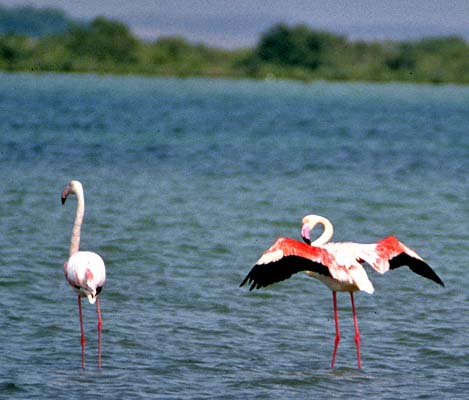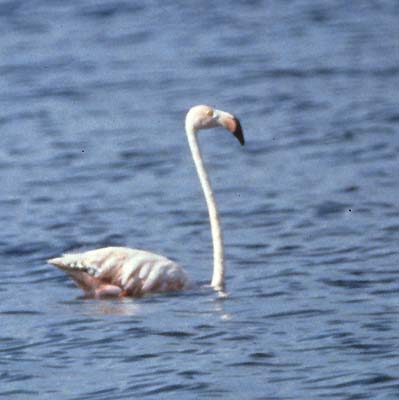
a web page by Don Roberson |
 |
FLAMINGOS Phoenicopteridae |
||
|
||
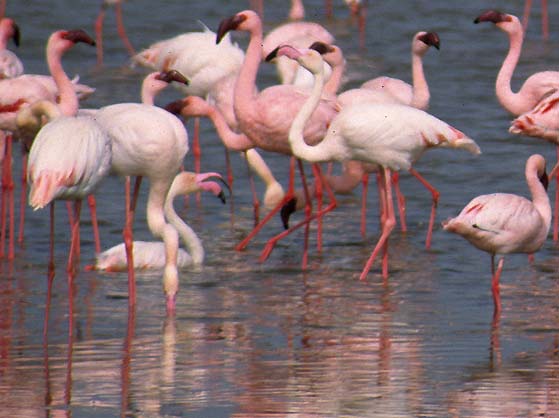 A
riot of pink flamingos brightens the alkaline lakes of the east African
rift. These shots (above, left & below) are from Ngorongoro Crater
in Tanzania, but huge flocks can brighten other lakes as well: Bogoria
and Nakuru in Kenya are also famed for their flamingos. The flocks are
composed of Lesser Flamingos (smaller, dark bills, pinker plumage) and
Greater Flamingo (larger; black-tipped pink bills). Greater Flamingos
feed on brine-shrimp in the shallows, reaching down — which turns the
bent bills 'upside down' — and filtering out the shrimp in the briny
solution. This filter-feeding behavior is unique among birds, and is
closer to huge baleen whales than anything else. The deeper-keeled bill
of Lesser Flamingo sucks up blue-green algae and diatoms at the
surface. Thus the two species do not compete for food on the same
lakes. Flamingos outside of Africa take in brine-fly larvae and snails
in coastal shallows (del Hoyo 1992). A
riot of pink flamingos brightens the alkaline lakes of the east African
rift. These shots (above, left & below) are from Ngorongoro Crater
in Tanzania, but huge flocks can brighten other lakes as well: Bogoria
and Nakuru in Kenya are also famed for their flamingos. The flocks are
composed of Lesser Flamingos (smaller, dark bills, pinker plumage) and
Greater Flamingo (larger; black-tipped pink bills). Greater Flamingos
feed on brine-shrimp in the shallows, reaching down — which turns the
bent bills 'upside down' — and filtering out the shrimp in the briny
solution. This filter-feeding behavior is unique among birds, and is
closer to huge baleen whales than anything else. The deeper-keeled bill
of Lesser Flamingo sucks up blue-green algae and diatoms at the
surface. Thus the two species do not compete for food on the same
lakes. Flamingos outside of Africa take in brine-fly larvae and snails
in coastal shallows (del Hoyo 1992). |
||
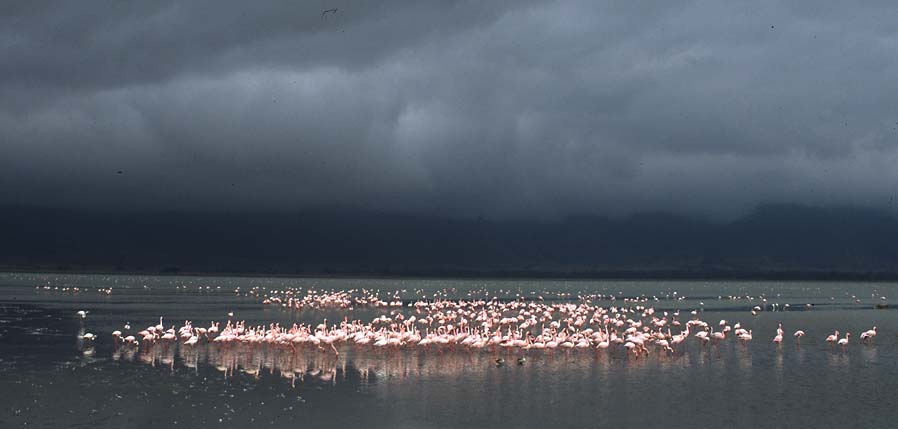 |
||
Recent genetic data suggests that the closest living relatives of the flamingos are the grebes (e.g., van Tuinen et al. 2001, Hackett et al. 2008), as does a sister relationship between their ischnoceran lice (Johnson et al. 2006), and most recent authorities (e.g., A.O.U., S.A.C.C.) now place these two very ancient groups next to each other in any taxonomic listing. Both have no close living relatives. While Lesser Flamingo is restricted to the African continent, Greater Flamingo has a wide range from marshes in southern France and Spain through the Persian Gulf (below left) to India. Many populations forage in shallow seas. There is a population of similar pink-billed, pale-plumaged flamingos in the New World: around the Caribbean and in the Galapagos. Sangster (1997) reviewed the evidence for species rank of Old World and New World birds, and this as now been widely accepted. The Caribbean/Galapagos populations are now called American Flamingo. Like Old World flamingos, they can wade chest deep to forage (below right, in Bonaire). |
||
|
||
| Flamingos nest colonially, usually on shallow islands in the saline lakes, where they are protected from predators. When the water level drops, predation is a problem. African birds are beset by foraging hyenas or Marabou Storks, and jackals hunt the edges for scraps (Golden Jackal in Ngorongoro, edging near Lesser Flamingos, below). | ||
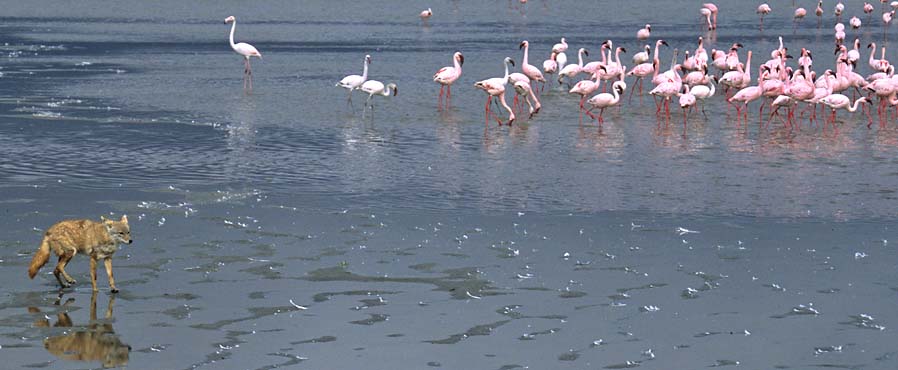 |
||
| There are three more species of flamingo in South America. A few Chilean Flamingo are sprinkled in the far distance in this Peruvian coastal scene (below). These occur on coastal estuaries but breed at high elevation Andean lakes. Andean Flamingo Phoenicoparrus andinus and Puna (James's) Flamingo P. jamesi are entirely localized to the high Andes of southern Peru, northern Chile, western Bolivia, and northwest Argentina. The occur on high altitude salt lakes, mainly above 3500 m (over 11,000'). | ||
 |
||
Photos: The flock of Greater Flamingo Phoenicopterus roseus and Lesser Flamingo Phoeniconaias minor were in Ngorongoro Crater, Tanzania, on 8 Aug 2002 (as was the Golden Jackal Canis aureus). The Greater Flamingos on the Persian Gulf were at Khor al Beidah, United Arab Emirates, in Mar 2001. The American Flamingo Phoenicopterus ruber was on Bonaire, Netherlands Antilles, in Aug 1985. The distant Chilean Flamingo Phoenicopterus chilensis were at Paracas, Peru, on 12 June 1985. Photos © Don Roberson; all rights reserved. Bibliographic note: There is no "family book" per se, but a good introduction to the family, with some fine photos, is in del Hoyo (1992). Literature cited:
|
